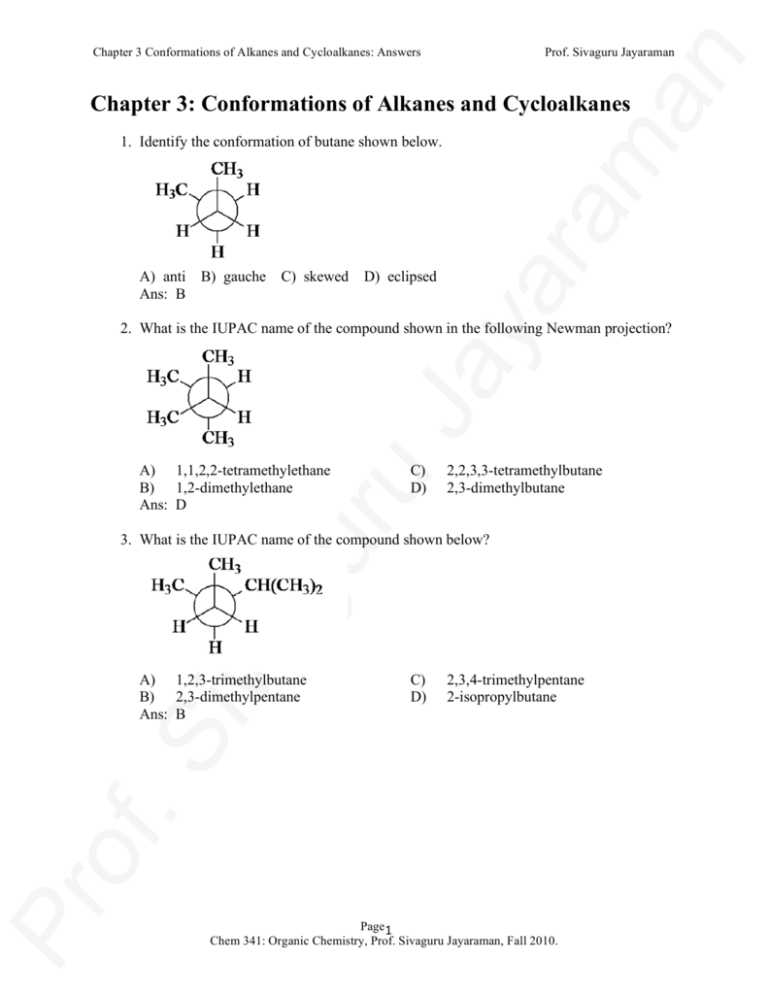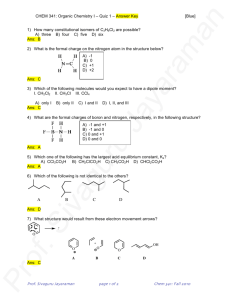Chapter 3: Conformations of Alkanes and
advertisement

Chapter 3 Conformations of Alkanes and Cycloalkanes: Answers Prof. Sivaguru Jayaraman Chapter 3: Conformations of Alkanes and Cycloalkanes 1. Identify the conformation of butane shown below. A) anti Ans: B B) gauche C) skewed D) eclipsed 2. What is the IUPAC name of the compound shown in the following Newman projection? A) 1,1,2,2-tetramethylethane B) 1,2-dimethylethane Ans: D C) D) 2,2,3,3-tetramethylbutane 2,3-dimethylbutane 3. What is the IUPAC name of the compound shown below? A) 1,2,3-trimethylbutane B) 2,3-dimethylpentane Ans: B C) D) 2,3,4-trimethylpentane 2-isopropylbutane Page 1 Chem 341: Organic Chemistry, Prof. Sivaguru Jayaraman, Fall 2010. Chapter 3 Conformations of Alkanes and Cycloalkanes: Answers Prof. Sivaguru Jayaraman 4. What is the dihedral (torsion) angle between the two bromine atoms in the following sawhorse drawing? A) 0o B) 30o Ans: C C) 60o D) 90o 5. At room temperature, the various conformations of butane A) do not interconvert; only the anti form is present. B) do not interconvert, but all conformations are present. C) interconvert very slowly. D) interconvert very rapidly. Ans: D 6. Which statement is correct concerning the relative stabilities of the two conformations, A and B, below? A) B) C) D) A is more stable. B is more stable. A and B are equal in stabilities. A and B are not equal in stability, but the preferred conformation cannot be determined by inspection. Ans: C Page 2 Chem 341: Organic Chemistry, Prof. Sivaguru Jayaraman, Fall 2010. Chapter 3 Conformations of Alkanes and Cycloalkanes: Answers Prof. Sivaguru Jayaraman 7. Identify the spatial relationship of the two chlorine atoms. A) gauche B) anti Ans: B C) eclipsed D) twist 8. Which statement is correct concerning the relative stabilities of the two conformations, A and B, below? A) B) C) D) A is more stable. B is more stable. A and B are equal in stabilities. A and B are not equal in stability, but the preferred conformation cannot be determined by inspection. Ans: B 9. What is the IUPAC name of the following compound? A) trans-1,4-dimethylcyclohexane B) cis-1,4-dimethylcyclohexane Ans: A C) D) trans-1,3-dimethylcyclohexane cis-1,3-dimethylcyclohexane Page 3 Chem 341: Organic Chemistry, Prof. Sivaguru Jayaraman, Fall 2010. Chapter 3 Conformations of Alkanes and Cycloalkanes: Answers Prof. Sivaguru Jayaraman 10. What is the dihedral (torsion) angle between the two bromine atoms in the wedge-anddash drawing below? A) 60o B) 90o Ans: D C) 120o D) 180o 11. Identify the relationship between the following two structures. A) B) C) D) Ans: constitutional isomers stereoisomers different conformations of the same compound identical C 12. Predict which of the following constitutional isomers of C5H10 would have the highest heat of combustion? A) methylcyclobutane C) cis-1,2-dimethylcyclopropane B) cyclopentane D) trans-1,2-dimethylcyclopropane Ans: C 13. Identify the two atoms anti to the bromine. A) the equatorial H's on C-2 and C-6 B) the axial H's on C-2 and C-6 Ans: D C) D) C-2 and C-6 C-3 and C-5 Page 4 Chem 341: Organic Chemistry, Prof. Sivaguru Jayaraman, Fall 2010. Chapter 3 Conformations of Alkanes and Cycloalkanes: Answers Prof. Sivaguru Jayaraman 14. Cyclohexane adopts the chair conformation rather than a planar structure because I. torsional strain is minimized. II. the C—C—C bond angles are close to 109.5o. III. there are no 1,3-diaxial interactions in a planar structure. A) only I B) only II C) I and II D) I, II, and III Ans: C 15. Identify the relationship between the following two structures. A) B) C) D) Ans: constitutional isomers stereoisomers different conformations of the same compound identical B 16. The most stable conformation of the compound shown has A) B) C) D) Ans: all methyl groups equatorial. equatorial methyl groups at C-1 and C-2, axial at C-4. equatorial methyl groups at C-1 and C-4, axial at C-2. equatorial methyl groups at C-2 and C-4, axial at C-1. D 17. The most stable chair conformation of cis-1-tert-butyl-3-methylcyclohexane has A) both groups equatorial. B) both groups axial. C) the tert-butyl group equatorial and the methyl group axial. D) the tert-butyl group axial and the methyl group equatorial. Ans: A Page 5 Chem 341: Organic Chemistry, Prof. Sivaguru Jayaraman, Fall 2010. Chapter 3 Conformations of Alkanes and Cycloalkanes: Answers Prof. Sivaguru Jayaraman 18. Identify the relationship of the two compounds below. A) B) C) D) Ans: identical constitutional isomers stereoisomers different conformations of the same compound C Page 6 Chem 341: Organic Chemistry, Prof. Sivaguru Jayaraman, Fall 2010. Chapter 3 Conformations of Alkanes and Cycloalkanes: Answers Prof. Sivaguru Jayaraman 19. Identify the correct stereoisomer and the most stable conformation of the following compound. A) A B) B C) C D) D Ans: B Page 7 Chem 341: Organic Chemistry, Prof. Sivaguru Jayaraman, Fall 2010. Chapter 3 Conformations of Alkanes and Cycloalkanes: Answers Prof. Sivaguru Jayaraman 20. Identify the relationship of the two compounds below. A) B) C) D) Ans: identical constitutional isomers stereoisomers different conformations of the same compound A 21. What is the IUPAC name of the following compound? A) bicyclo[2.2.2]octane B) bicyclo[2.2.2]hexane Ans: A C) D) bicyclo[3.3.3]octane bicyclo[3.3.3]hexane 22. Which statement below is true concerning the conversion of cis-1,4dimethylcyclohexane to trans-1,4-dimethylcyclohexane? A) The conversion takes place by chair conformation ring-flipping. B) You cannot do the conversion without breaking covalent bonds. C) The conversion takes place by rotating the C(1)-C(2) bond by 180°. D) The conversion takes place through the skew boat conformations. Ans: B 23. What is the IUPAC name of the following bicycloalkane? A) bicyclo[6.3.0]heptane B) bicyclo[4.1.0]hexane Ans: D C) D) bicyclo[4.2.1]hexane bicyclo[4.1.0]heptane Page 8 Chem 341: Organic Chemistry, Prof. Sivaguru Jayaraman, Fall 2010. Chapter 3 Conformations of Alkanes and Cycloalkanes: Answers Prof. Sivaguru Jayaraman 24. Identify the relationship between the following two structures. A) B) C) D) Ans: identical different conformations of the same compound stereoisomers constitutional isomers C Page 9 Chem 341: Organic Chemistry, Prof. Sivaguru Jayaraman, Fall 2010. Chapter 3 Conformations of Alkanes and Cycloalkanes: Answers Prof. Sivaguru Jayaraman 25. Which isomer of 1-tert-butyl-3-ethyl-5-methylcyclohexane below is thermodynamically the most stable? A) A B) B C) C D) D Ans: A 26. What would the C—C—C bond angles be in a planar cyclohexane? A) 60o B) 90o C) 109.5o D) 120o Ans: D Page 10 Chem 341: Organic Chemistry, Prof. Sivaguru Jayaraman, Fall 2010. Chapter 3 Conformations of Alkanes and Cycloalkanes: Answers Prof. Sivaguru Jayaraman 27. Identify the relationship between the following two Newman projections. A) B) C) D) Ans: identical stereoisomers different conformations of the same compound constitutional isomers C 28. The IUPAC name of the following compound is A) cis-1,2-dimethylcyclohexane. B) trans-1,2-dimethylcyclohexane. Ans: A C) D) 1,1-dimethylcyclohexane. cis-1,3-dimethylcyclohexane. C) D) trans-1,3-dimethylcyclohexane. trans-1,4-dimethylcyclohexane. 29. The following structure is A) cis-1,3-dimethylcyclohexane. B) cis-1,4-dimethylcyclohexane. Ans: C Page 11 Chem 341: Organic Chemistry, Prof. Sivaguru Jayaraman, Fall 2010. Chapter 3 Conformations of Alkanes and Cycloalkanes: Answers Prof. Sivaguru Jayaraman 30. The sawhorse drawing of butane below is A) B) C) D) Ans: a gauche conformation. the anti conformation. the least stable eclipsed conformation. the most stable eclipsed conformation. A 31. The sawhorse drawing of butane below is the A) least stable staggered conformation. B) most stable staggered conformation. Ans: C C) D) least stable eclipsed conformation. most stable eclipsed conformation. 32. Which constitutional isomer of dimethylcyclohexane does not exhibit cis-trans isomerism? A) 1,1-dimethylcyclohexane C) 1,3-dimethylcyclohexane B) 1,2-dimethylcyclohexane D) 1,4-dimethylcyclohexane Ans: A Page 12 Chem 341: Organic Chemistry, Prof. Sivaguru Jayaraman, Fall 2010. Chapter 3 Conformations of Alkanes and Cycloalkanes: Answers Prof. Sivaguru Jayaraman 33. What is the estimated dihedral angle between the two methyl groups on the structure shown below? A) 30o B) 60o Ans: B C) 90o D) 120o 34. Which one of the following is a stereoisomer isomer of trans-1,3dimethylcyclopentane? A) 1,1-dimethylcyclopentane C) ethylcyclopentane B) cis-1,2-dimethylcyclopentane D) cis-1,3-dimethylcyclopentane Ans: D 35. Which of the following best describes the conformation of propane shown below? A) B) C) D) Ans: C(1) - C(2) staggered and C(2) - C(3) staggered C(1) - C(2) staggered and C(2) - C(3) eclipsed C(1) - C(2) eclipsed and C(2) - C(3) staggered C(1) - C(2) eclipsed and C(2) - C(3) eclipsed C Page 13 Chem 341: Organic Chemistry, Prof. Sivaguru Jayaraman, Fall 2010. Chapter 3 Conformations of Alkanes and Cycloalkanes: Answers Prof. Sivaguru Jayaraman 36. Which one of the following is the butane conformation shown below? A) gauche B) anti Ans: A C) skew D) eclipsed 37. What is the correct IUPAC name of the following compound? A) cis-1-ethyl-2-methylcyclohexane B) trans-1-ethyl-2-methylcyclohexane Ans: B C) D) cis-1-ethyl-6-methylcyclohexane trans-1-ethyl-6-methylcyclohexane 38. Which of the following can have cis-trans stereoisomers? A) 1,1-dimethylcyclobutane C) 1,1,3-trimethylcyclobutane B) 1,3-dimethylcyclobutane D) 1,1,3,3-tetramethylcylclobutane Ans: B 39. The C—C—C bond angle in cyclopropane is A) 60o. B) 90o. C) 109.5o. D) 120o. Ans: A 40. The most stable conformation of cis-4-methyl-1-tert-butylcyclohexane is a chair conformation with A) both the -CH3 and -C(CH3)3 equatorial. B) both the -CH3 and -C(CH3)3 axial. C) the -CH3 equatorial and the -C(CH3)3 axial. D) the -CH3 axial and -C(CH3)3 equatorial. Ans: D Page 14 Chem 341: Organic Chemistry, Prof. Sivaguru Jayaraman, Fall 2010. Chapter 3 Conformations of Alkanes and Cycloalkanes: Answers Prof. Sivaguru Jayaraman 41. What is the IUPAC name of the compound shown below? A) cis-1,3-dimethylcyclohexane B) trans-1,3-dimethylcyclohexane Ans: B C) D) cis-1,4-dimethylcyclohexane trans-1,5-dimethylcyclohexane 42. What is the IUPAC name of the compound shown below? A) cis-1,2-diethylcyclobutane B) trans-1,2-diethylcyclobutane Ans: C C) D) cis-1,3-diethylcyclobutane trans-1,3-diethylcyclobutane 43. Which is more stable, cis-1,3-dimethylcyclohexane or trans-1,3-dimethylcyclohexane? A) trans-1,3-dimethylcyclohexane B) cis-1,3-dimethylcyclohexane C) They are equally stable. D) Stabilities of cis, trans stereoisomers cannot be compared. Ans: B Page 15 Chem 341: Organic Chemistry, Prof. Sivaguru Jayaraman, Fall 2010. Chapter 3 Conformations of Alkanes and Cycloalkanes: Answers Prof. Sivaguru Jayaraman 44. What is the relationship between the following two structures? A) B) C) D) Ans: identical stereoisomers different conformations of the same compound constitutional isomers D 45. How many alkyl groups would be equatorial in the most stable conformation of the cyclohexane below? A) one B) two Ans: B C) three D) four 46. Menthol is the most stable isomer of 2-isopropyl-5-methylcyclohexanol. Which compound is it? A) A B) B C) C D) D Ans: C Page 16 Chem 341: Organic Chemistry, Prof. Sivaguru Jayaraman, Fall 2010. Chapter 3 Conformations of Alkanes and Cycloalkanes: Answers Prof. Sivaguru Jayaraman 47. The planar form of which ring would have bond angles close to the tetrahedral value but is destabilized by eclipsing interactions? A B C A) A B) B C) C D) D Ans: C D 48. Consider these two molecules; which statement is true? I II A) I is more stable than II. B) II is more stable than I. Ans: B C) D) I and II are equally stable. There is no way to predict this. 49. Which of the staggered conformations of 2-methylbutane is most stable? CH3 CH3 H H CH3 A H3 C CH3 H H B H CH3 H3CCH3 CH3 H H H H H CH3 H CH CH3 H 3 D C A) A B) B C) C D) D Ans: A 50. What would be the least stable isomer of 1,2,3,4,5,6-hexamethylcyclohexane? A B C D A) A B) B C) C D) D Ans: A Page 17 Chem 341: Organic Chemistry, Prof. Sivaguru Jayaraman, Fall 2010. Chapter 3 Conformations of Alkanes and Cycloalkanes: Answers Prof. Sivaguru Jayaraman 51. What is the most specific name for the conformation shown? H CH3 CH3 H H H A) anti Ans: C B) staggered C) gauche D) eclipsed 52. β-D-Glucose is the six-carbon sugar with all non-hydrogen groups equatorial. Which structure is it? CH2OH CH2OH HO HO O HO A OH HO HO O OH HO OH O O OH B CH2OH CH2OH HO OH C OH HO OH D A) A B) B C) C D) D Ans: B Page 18 Chem 341: Organic Chemistry, Prof. Sivaguru Jayaraman, Fall 2010. OH








